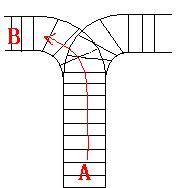HDU 1022 Train Problem I
来源:互联网 发布:鼎捷软件股票 编辑:程序博客网 时间:2024/06/10 20:26
题目链接:点击打开链接
Train Problem I
Time Limit: 2000/1000 MS (Java/Others) Memory Limit: 65536/32768 K (Java/Others)Total Submission(s): 36011 Accepted Submission(s): 13576
Problem Description
As the new term comes, the Ignatius Train Station is very busy nowadays. A lot of student want to get back to school by train(because the trains in the Ignatius Train Station is the fastest all over the world ^v^). But here comes a problem, there is only one railway where all the trains stop. So all the trains come in from one side and get out from the other side. For this problem, if train A gets into the railway first, and then train B gets into the railway before train A leaves, train A can't leave until train B leaves. The pictures below figure out the problem. Now the problem for you is, there are at most 9 trains in the station, all the trains has an ID(numbered from 1 to n), the trains get into the railway in an order O1, your task is to determine whether the trains can get out in an order O2.






Input
The input contains several test cases. Each test case consists of an integer, the number of trains, and two strings, the order of the trains come in:O1, and the order of the trains leave:O2. The input is terminated by the end of file. More details in the Sample Input.
Output
The output contains a string "No." if you can't exchange O2 to O1, or you should output a line contains "Yes.", and then output your way in exchanging the order(you should output "in" for a train getting into the railway, and "out" for a train getting out of the railway). Print a line contains "FINISH" after each test case. More details in the Sample Output.
Sample Input
3 123 3213 123 312
Sample Output
Yes.inininoutoutoutFINISHNo.FINISHFor the first Sample Input, we let train 1 get in, then train 2 and train 3.So now train 3 is at the top of the railway, so train 3 can leave first, then train 2 and train 1.In the second Sample input, we should let train 3 leave first, so we have to let train 1 get in, then train 2 and train 3.Now we can let train 3 leave.But after that we can't let train 1 leave before train 2, because train 2 is at the top of the railway at the moment.So we output "No.".HintHint
题意是有n辆火车,以1的方式进栈,能不能以2的方式出栈,可以中途进栈出栈。
用两个字符串数组储存方式一二,用栈来判断是否可以出栈入栈,需要一个数组来记录,出栈为0,入栈为1.
需要特别注意的是,i++和++i的判定,若i==n则说明无法完成题目要求,此时,就要用++i来判定。感觉说不清楚,用代码解释一下吧还是。
代码实现:
#include<iostream>#include<stack>#include<cstring>using namespace std;int main(){char a[10005],b[10005];int n,i,j,k,visit[10005];stack <char>s;while(cin>>n>>a>>b){memset(visit,0,sizeof(visit)); //清空数组 s.push(a[0]); //先压入栈,防止栈为空 visit[0]=1; //标记,入栈 i=0;j=0;k=1;while(i<n&&j<n) //i跟j同时等于n时,循环结束 {if(!s.empty()&&(s.top()==b[j])) //栈非空且栈首等于b中的元素 { j++; //后移 visit[k++]=0; //标记出栈 s.pop(); //弹出 }else{if(i==n) //i等于n表示栈顶元素不等于b中元素且a已经完成遍历 break;s.push(a[++i]); //如果是i++,则会出现i等于n时,还没判断b中是否存在,就已经跳出循环 visit[k++]=1; //标记入栈 }}while(!s.empty()) //清空栈 s.pop(); if(i==n){cout<<"No."<<endl<<"FINISH"<<endl;}else{cout<<"Yes."<<endl;for(i=0;i<k;i++)if(visit[i])cout<<"in"<<endl;elsecout<<"out"<<endl;cout<<"FINISH"<<endl;}}return 0;} 0 0
- HDU 1022 Train Problem I
- HDU-1022 Train Problem I
- HDU 1022 Train Problem I
- HDU 1022 ( Train Problem I )
- HDU 1022 Train Problem I
- HDU 1022 Train Problem I
- Hdu 1022 - Train Problem I
- HDU-1022:Train Problem I
- hdu 1022 Train Problem I
- hdu 1022 Train Problem I
- hdu-Train Problem I-1022
- hdu 1022 Train Problem I
- hdu 1022 Train Problem I
- hdu 1022 Train Problem I
- HDU 1022 Train Problem I
- hdu 1022 Train Problem I
- hdu 1022 Train Problem I
- HDU 1022Train Problem I
- 远程访问服务器时,出现no supported authentication methods available
- 希尔排序算法
- 冒泡排序法C#实现
- 421. Maximum XOR of Two Numbers in an Array
- PAT_1052. Linked List Sorting
- HDU 1022 Train Problem I
- 安卓异常android.widget.TextView cannot be cast to android.widget.Button
- 希尔排序算法
- 硬盘变成RAW 修复
- invalid nib registered for identifier。。。nib must contain exactly one top level
- java类的初始化顺序
- C++实现单链表
- android在代码中设置View的属性
- 从误用TreeSet到思考Java有序集合对相等和顺序比较一致性的要求


